While it might seem simple, keeping your kitchen knives clean and sharp is crucial for safe and efficient food preparation. Whether using a chef's knife or a paring knife, clean them thoroughly after each use, significantly when cutting raw meat, poultry, or fish, to prevent cross-contamination.
This comprehensive guide provides expert tips on properly cleaning and maintaining your knives, ensuring their longevity and performance. Investing in good-quality knives and learning the proper cleaning techniques can keep your kitchen tools pristine for years.
Introducing clean kitchen knives into your culinary routine is essential for maintaining safety and efficiency. Properly cleaned knives enhance hygiene and extend the life and sharpness of your blades.
As indispensable kitchen tools, knives require diligent care to stay in prime condition. Regardless of the types of knives you have – be it butcher, chef, or paring knives – each one benefits from proper cleaning techniques.
This blog will walk you through the essential steps on how to clean a kitchen knife, ensuring they remain sharp, rust-free, and ready for culinary challenges.
Pay attention not only to the blade but also to the knife handle material, as different materials require specific cleaning methods to maintain their integrity. Let's start on the path to perfectly clean and sharp kitchen knives!
Why You Should Always Clean Your Knife
Your kitchen knife is like a trusted teammate in your kitchen. Just like you take care of yourself, proper cleaning keeps your knife blades performing at its best and protects you from harm.
Prevent Cross-Contamination
Raw meat, poultry, and fish can harbour nasty bacteria. Regular cleaning prevents these germs from riding your knife to other foods, surfaces, and utensils, keeping your food prep safe and preventing foodborne illness.
Extend Knife’s Life
Letting leftover food dry on your knife is like leaving dishes in the sink. It can stain and rust the blade. Proper cleaning keeps your knife looking sharp and shiny, like when you first brought it home.
Improved Cutting Performance
A dirty knife is a dull knife. It requires more force to cut through food, which can tear and damage what you're trying to prepare. Keeping your knife clean ensures smooth, effortless slicing.
Avoid Rusting
Leaving moisture and acidic or salty food residues on your knife can cause rust and corrosion. Moisture and salty or acidic foods can make your knife rust. Washing and drying your knife after each use prevents this from happening, keeping your blade in top condition.
When to Wash Your Knife for Kitchen Safety
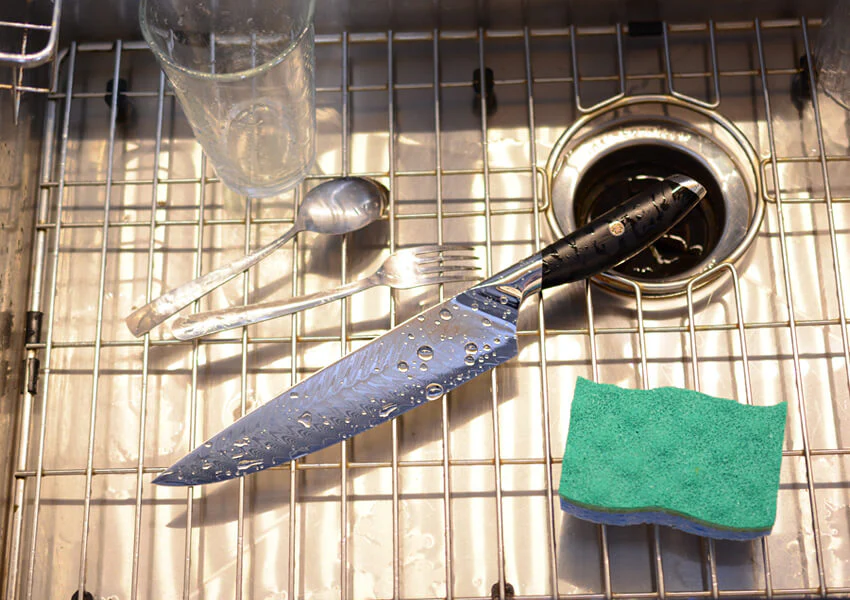
Keeping your knives clean is an essential part of kitchen safety. Here's a knife cleaning schedule with some critical times to grab the dish soap and scrub:
After Cutting Raw Meat
Raw meat can harbour bacteria you don't want to spread around your clean kitchen. Clean and sanitise your knife immediately after cutting up meat to avoid cross-contamination, which can make you sick. Think of it like washing your hands after handling raw meat – your knife needs a good cleaning, too!
Before Storing in a Knife Block
Make sure your knife is thoroughly cleaned and sanitised before storing it. The blade and handle can accumulate bacteria, especially after use with raw meats, fish, poultry, and eggs. Storing a dirty knife can allow bacteria to multiply, potentially contaminating utensil drawers, knife blocks, and other knives.
How to Clean a Kitchen Knife Like a Pro
Have you just finished chopping veggies or prepping protein? Here are the steps you need to follow for a quick and effective knife-cleaning routine:
What You’ll Need
- Warm water
- Soft sponge
- Dishcloth
- Mild dish soap
- soft-bristled toothbrush
- Cotton swab
- Sandpaper
- Compressed air blower
- Clean towel
- Food-grade mineral oil
- Paper towel
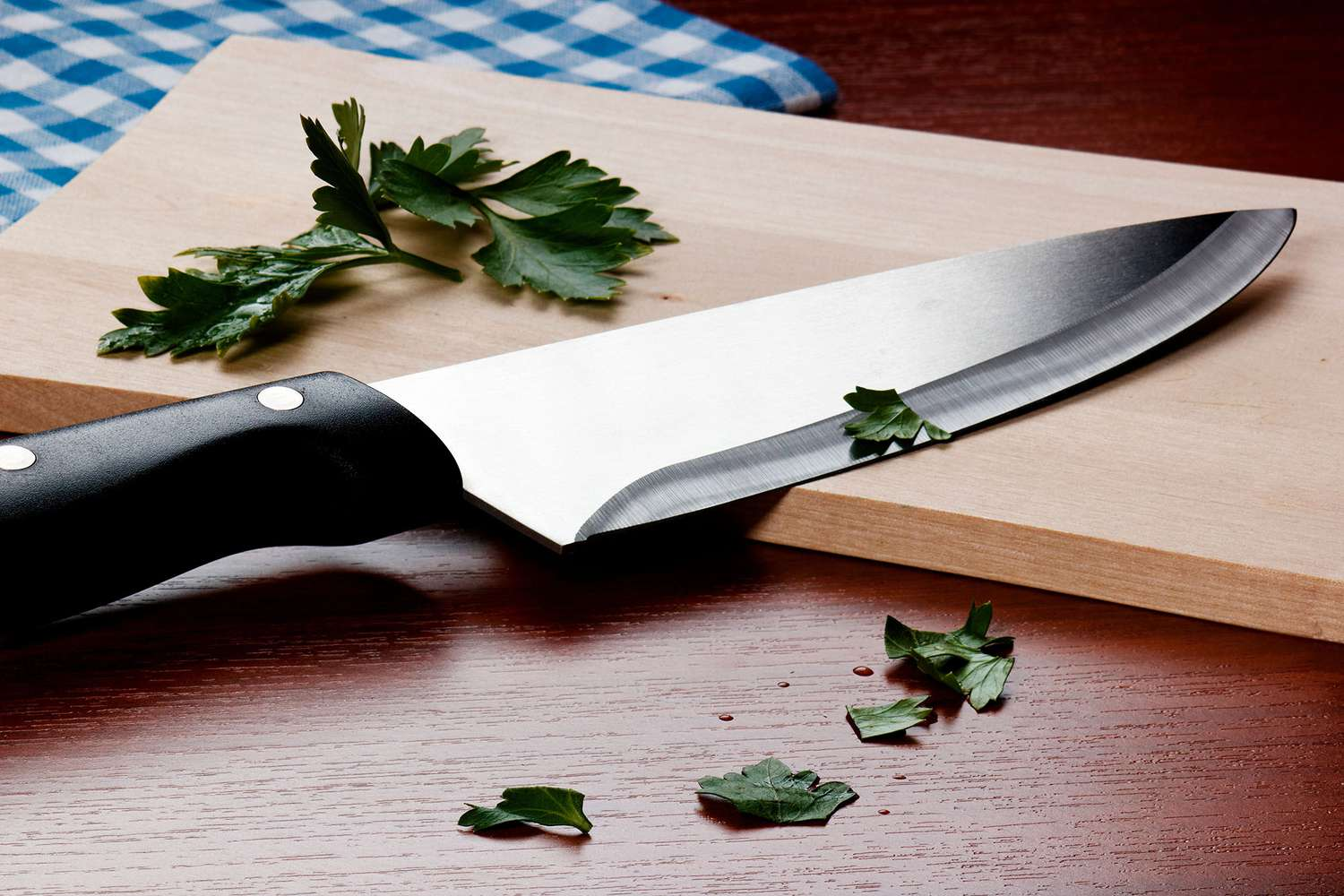
Instructions
1. Hold your kitchen knife’s handle firmly
Knife safety is paramount! Before starting, grab the knife by the handle and hold it firmly with a pinch grip.
Use your thumb and index finger to secure the handle near the bolster (the area where the blade meets the handle). It gives you reasonable control over the knife and prevents accidental slips during cleaning.
2. Rinse away excess food particles from your knife blade
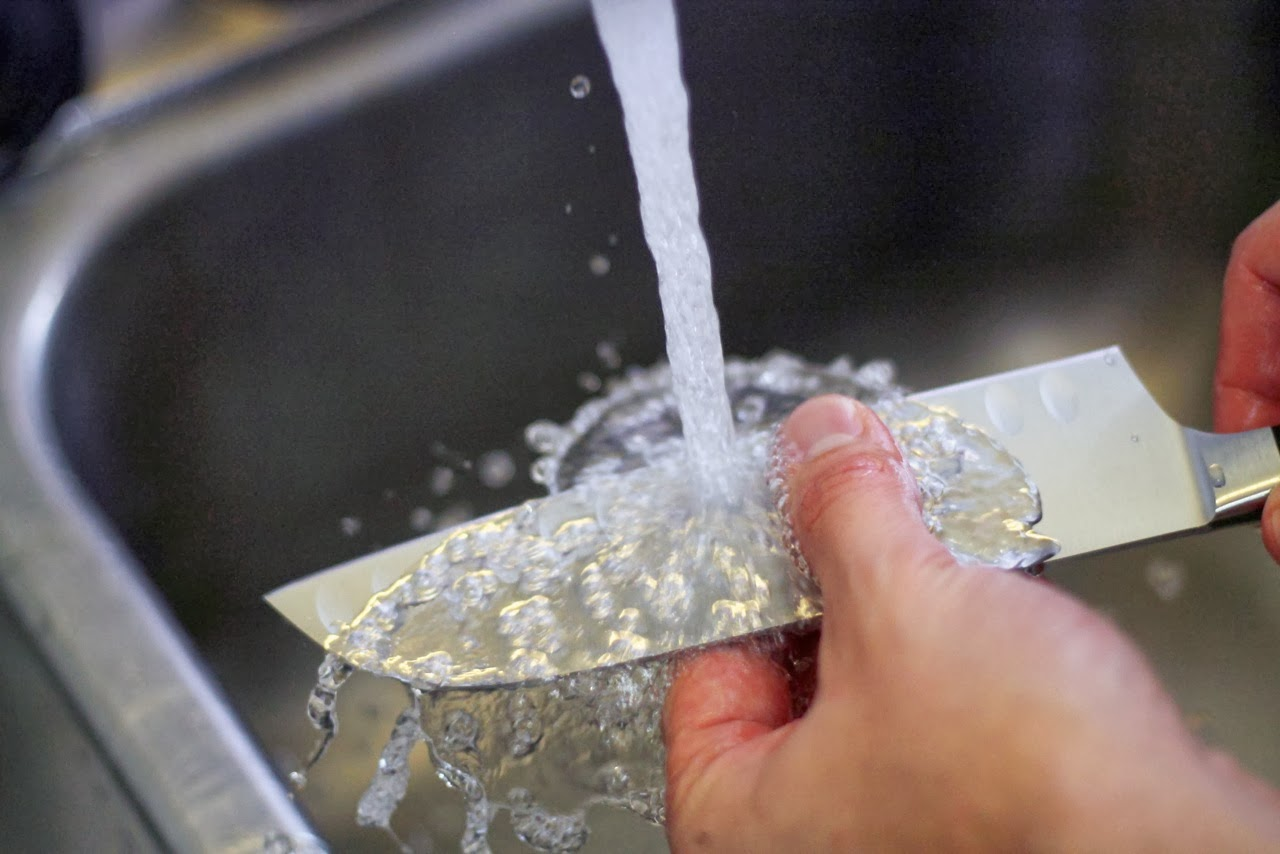
With the gripped knife, head over to the kitchen sink, turn on the tap and run warm water. Hold the knife at an angle, pointing the sharp edge downwards.
Let the water flow over the entire blade, rinsing away any loose food particles or debris. This initial rinse helps prevent food from drying onto the blade, making cleaning easier and reducing the risk of transferring bacteria.
Remember, keep the blade pointed down and away from you for ultimate safety as you rinse.
3. Tackle stubborn food and grime
Now that you've rinsed away loose food residue, tackling anything more stubborn is time. Grab a soft sponge or dishcloth and add a few drops of mild dish soap. Gently scrub the blade with your free hand to remove any stuck-on food or grime.
Avoid vigorous scrubbing. A quick slip could lead to a nasty cut. When scrubbing the blade, use gentle strokes in the direction running away from the sharp edge (from the spine towards the cutting edge). It minimises contact with the sharpest part of the knife.
Choose a cleaning position that feels most comfortable and secure. You can lay the knife flat on a cutting board, scrub one side at a time while holding the handle, or have the knife upright against the sink with the blade pointed downwards for added control.
4. Enlist the power of a soak (for stubborn food only)
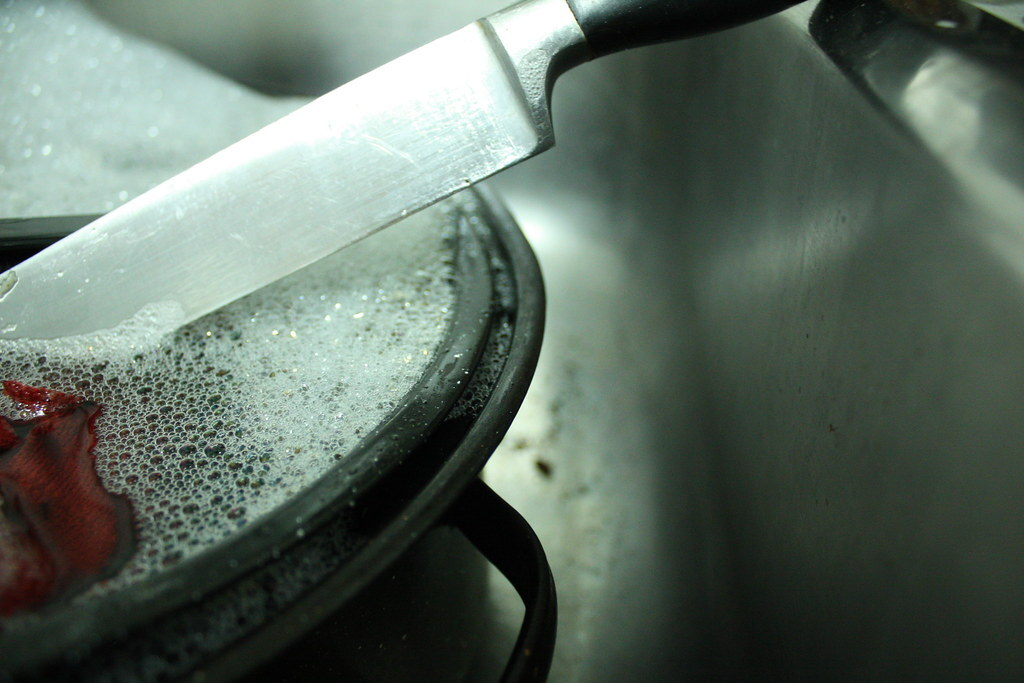
Sometimes, even the gentlest scrubbing can't conquer particularly stubborn food particles. In these cases, a quick soak can be your secret weapon!
Fill a shallow dish with warm, soapy water and gently submerge the blade (avoid submerging the handle if it's made of wood). Let the knife soak for 1-2 minutes, allowing the soapy water to loosen and dissolve any stuck-on food.
For particularly tough grime, consider using a soft-bristled toothbrush or a cotton swab to nudge dislodged food particles away from the blade gently.
Remember, avoid soaking knives for extended periods (more than a few minutes). Prolonged soaking can damage the blade (increasing the risk of rust) and potentially loosen or warp the handle, especially on wooden-handled knives.
5. Don’t forget the knife handle material
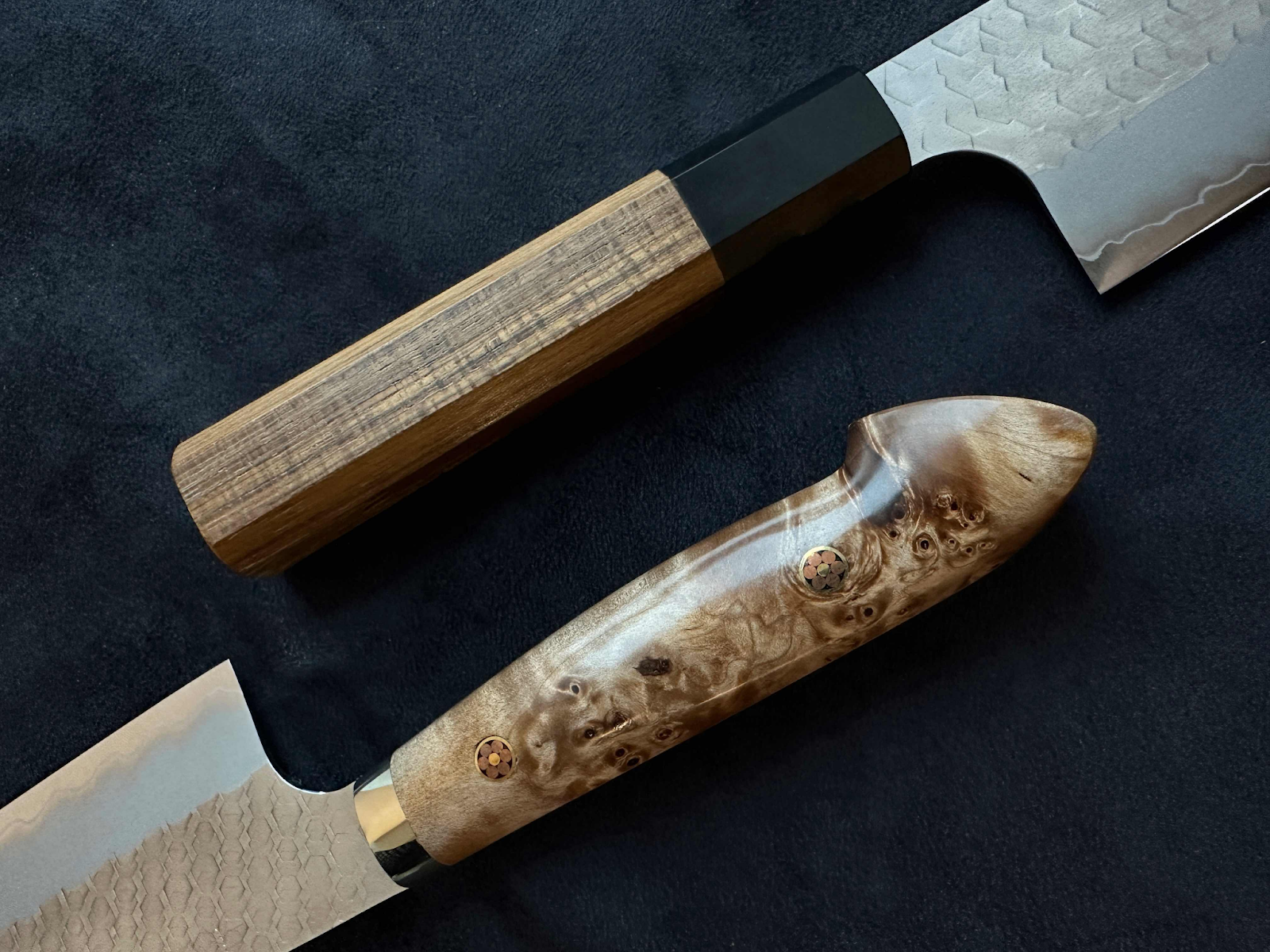
Now that the blade is sparkling clean, it's time to give the handle some love, too. Remember, a clean handle is just as crucial for overall knife hygiene.
Avoid harsh chemicals and excessive moisture for precious wooden handles. Simply wipe down the handle with a damp cloth using warm water. Polymer handles are generally more water-resistant. You can use the same warm, soapy water solution you used for the blade. However, avoid abrasive sponges or scouring pads, which can scratch the surface.
6. Clean the inside of the handle (Optional)
Over time, debris can accumulate inside the space where the blade meets the handle (known as the tang). It’s more common with knives that have complete tang construction. Consider using a folded piece of sandpaper (very fine grit) or a compressed air blower to gently remove any dust or dirt trapped inside for a deeper clean.
7. Rinse off and dry the kitchen knife
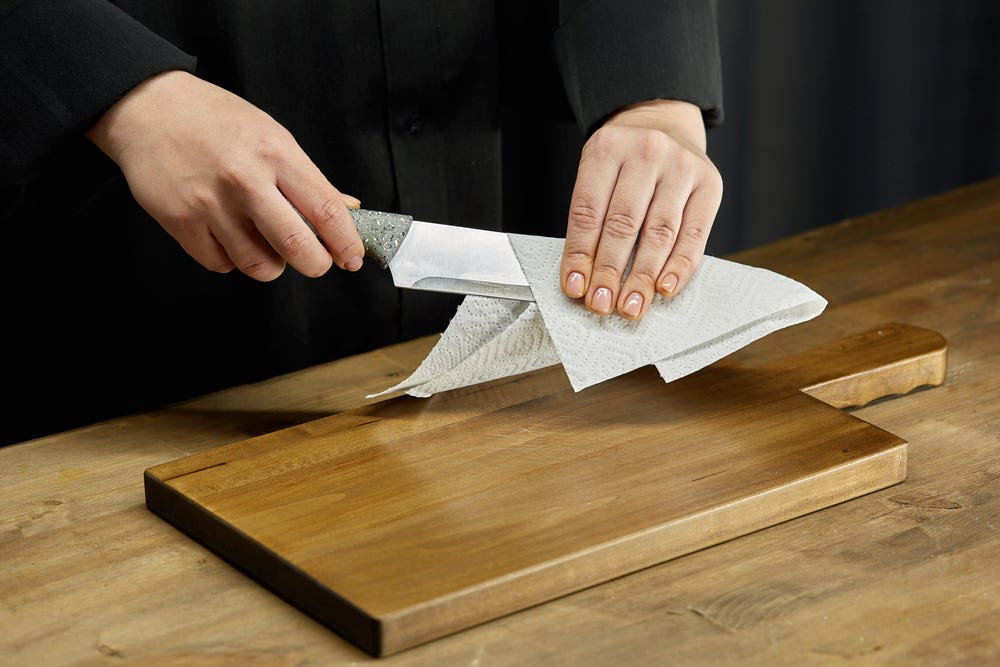
With your knife sparkling clean, it's time to banish any lingering water droplets. Remember, moisture is the enemy of sharp blades.
Give the entire knife a final rinse to remove residual soap suds under clean running water. Then, grab a clean dish towel and carefully dry the knife, including the blade and handle. Use a wiping motion away from the sharp edge to ensure the blade's safety.
Resist the urge to let your knife air dry. Even tiny water droplets can leave mineral deposits or, worse yet, lead to rust. A thorough drying ensures your knife stays sharp and pristine.
8. Shield and shine carbon steel knife with oil
Carbon steel knives are known for their exceptional sharpness but require extra TLC to prevent rust. After drying thoroughly, use a clean paper towel to apply a thin layer of food-grade mineral oil to the entire knife blade. It creates a protective barrier against moisture and helps your knife stay sharp and rust-free.
9. Store your kitchen knives safely in their own space
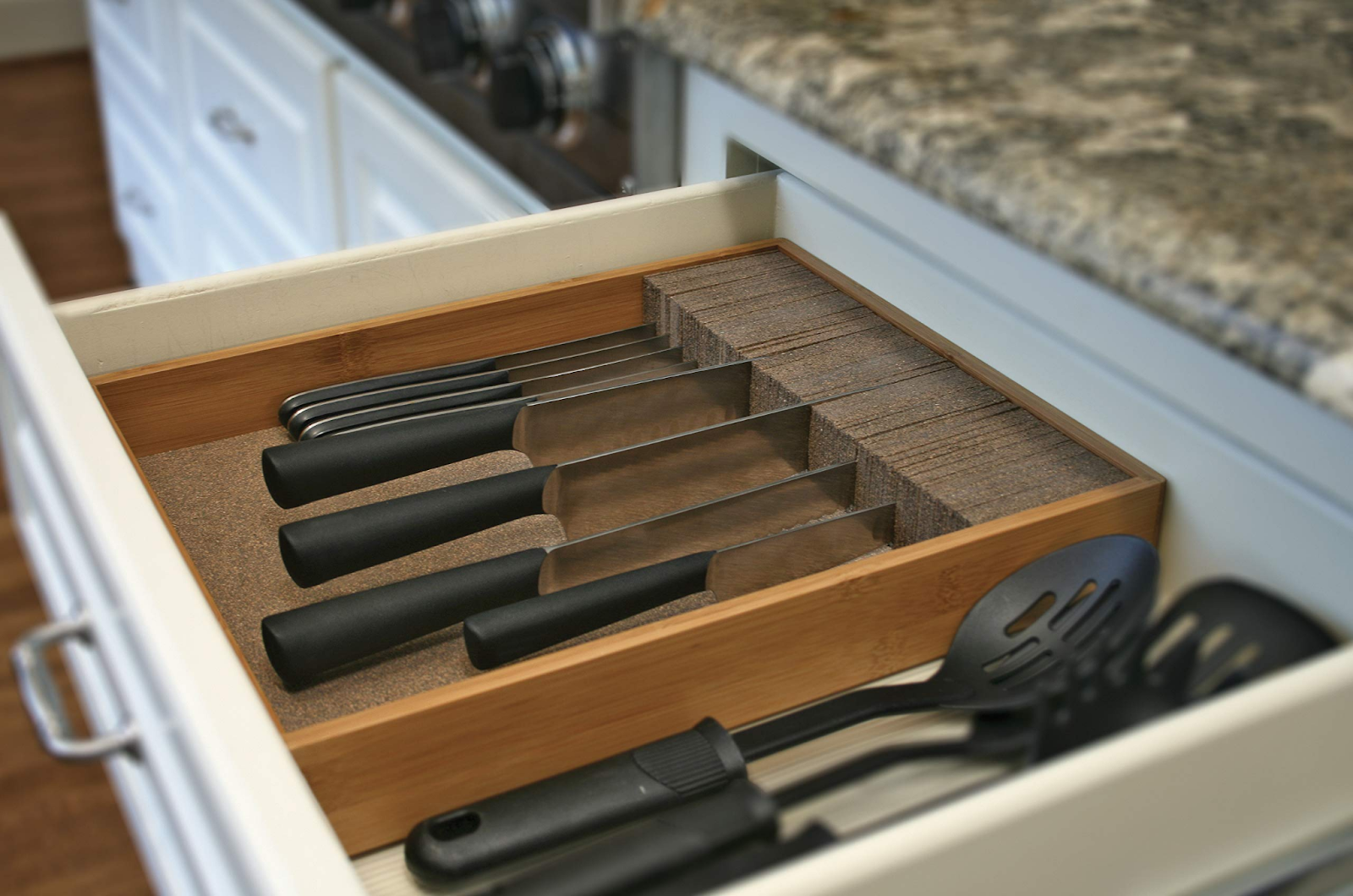
Since your knives are clean and dry, it is crucial to store them properly. Tossing them haphazardly in a drawer can damage your knives and fingers.
Dedicate a drawer specifically for knife storage. It keeps knives separate from other utensils, preventing nicks and scratches. A knife block provides a designated spot for each blade, keeping them organised and readily accessible. Choose a block made of wood or bamboo for a classic look or a magnetic block for a space-saving solution. Magnetic strips on your kitchen wall offer a sleek and space-saving storage option. Ensure the strip is strong enough to hold your knives' weight securely.
If drawer storage is unavoidable, invest in protective blade covers or sheaths to prevent accidental cuts and dings during rummaging.
Master Your Kitchen Knife Care for Culinary Confidence
These steps will ensure your trusty kitchen companions stay in top condition for years. It translates to maximised performance and a longer lifespan for your blades. Remember, well-maintained knives not only make food prep a breeze, but they're also safer to use.
Now that you're armed with this cleaning knowledge, you can confidently conquer any recipe and elevate your cooking skills. With the proper care outlined in this guide, you'll be well on your way to becoming a kitchen maestro. So grab your favourite knife, embrace the confidence of clean and sharp steel, and happy chopping!
FAQs:
1. Should I wash my knives in the dishwasher?
While a dishwasher is convenient for many kitchen tools, they could be better for knives. The harsh, high heat and drying cycles can dull the blade, loosen the handle (mainly wood), and even promote rust. Opt for handwashing with warm water and dish soap to keep your knives in top condition.
2. How can I remove rust from my knife?
Rust happens! But don't fret – a little TLC can bring your blade back to life.
Create a paste with baking soda and water. Apply the baking soda paste to the rusted area and let it sit for about an hour. Gently scrub off the paste with a soft cloth or sponge. Soak the blade (avoiding the handle) in white vinegar for 5 minutes for stubborn rust.
3. How often should I clean my knives?
You should wash your knives after each use. It removes food particles and debris that can dull the blade or harbour bacteria.
4. Are abrasive cleaners okay for cleaning knives?
Avoid abrasive materials, such as harsh detergents, steel wool, cleaning pads or scouring powders. These can scratch the blade, making it more prone to sticking and dulling faster. Instead, use gentle sponges or dishcloths with warm water and dish soap for a clean and protected blade.

